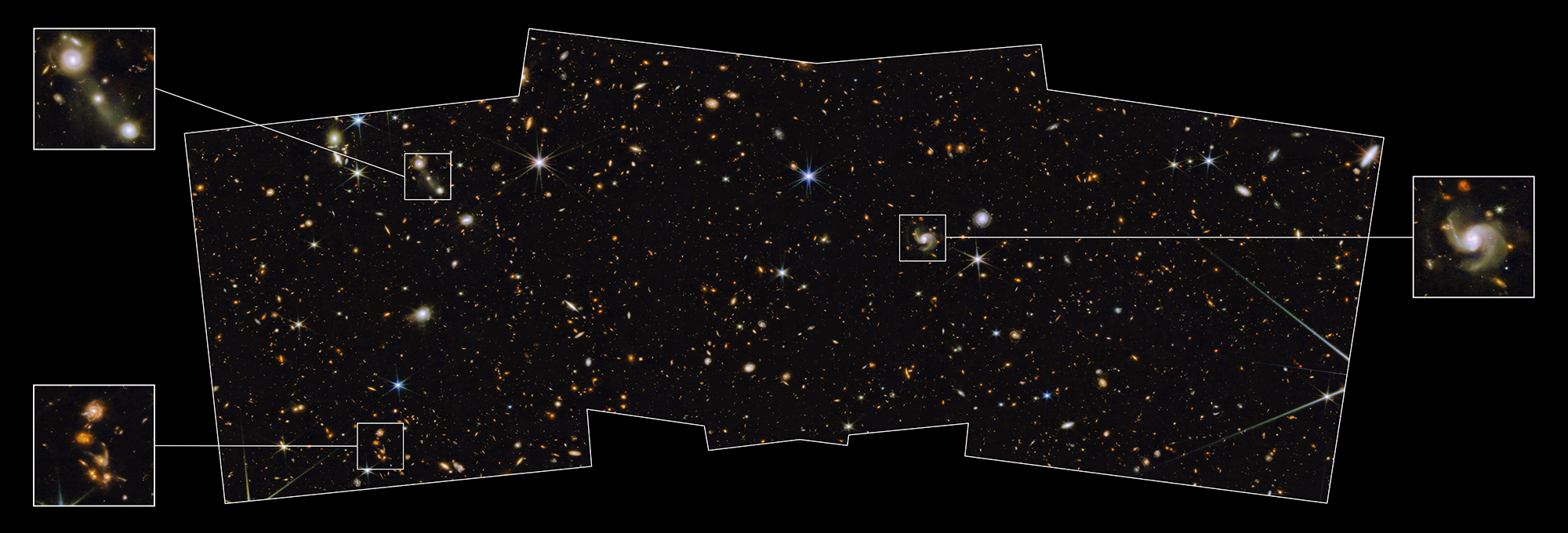
The image depicts the North Elliptical Pole measured with the highest precision by PEARLS, where thousands of galaxies coexist at great distances / NASA, ESA, CSA, STScI, Arizona State University, ICRAR/UWA, UofA.
The region of the sky discovered is known as the North Ecliptic Pole
15 December 2022
A team of researchers from NASA's Prime Extragalactic Areas for Reionization and Lensing Science (PEARLS) programme has obtained one of the first images of the universe with the greatest depth to date, showing a region of the sky known as the 'North Ecliptic Pole' filled with 'galactic diamonds'. The work with these results has been published today in the journal Astronomical Journal and the astrophysicist of the Institute of Physics of Cantabria (IFCA, CSIC-UC), José María Diego, is one of the authors.
The snapshot shows eight different colours of infrared light captured by the NIRCam instrument on NASA's James Webb Space Telescope, and magnified by the Hubble Space Telescope using ultraviolet light.
NIRCam is Webb's main imager / NASA, Chris Gunn.
In this way, a universe full of very bright galaxies previously unobserved by the largest ground-based telescopes, as well as an assortment of stars in the interior of the Milky Way, previously unknown to the scientific community, have been imaged in great detail and with great depth.
The North Elliptical Pole measured with highest precision by PEARLS / NASA, ESA, CSA, STScI, Arizona State University, ICRAR/UWA, UofA.
José María Diego is a CSIC astrophysicist at IFCA and a member of the PEARLS and J-PAS collaborations, which have also observed this field of the universe. "J-PAS is a Spanish-led project in which, using a unique Spanish telescope in the world, located in the Javalambre mountains (Teruel), some 8000 square degrees of the northern hemisphere will be observed in 54 different colours".
The telescope will start providing images in January 2023, and during its test period a year ago, it was able to observe the area known as the North Elliptical Pole with greater precision and detail. "Both PEARLS and J-PAS are collaborating and sharing their data to make the most of these observations, and their data will be used to study nearby galaxies and more distant groups of galaxies in detail", adds Diego.
"Brilliant images"
For Rogier Windhorst, a professor at Arizona State University (ASU) and PEARLS principal investigator, these Webb images "are incredible, allowing us to measure the number density of galaxies that shine down to very faint infrared limits and the total amount of light they produce".
"I was blown away by the first PEARLS images", agrees Rolf Jansen, ASU researcher and PEARLS co-investigator. "I could not have imagined, when I selected this field near the North Ecliptic Pole, that it would provide us with such a treasure trove of distant galaxies, and that we would get clues about the processes by which galaxies are created and grow. I can see jets, tails, shells and halos of stars at their peripheries, the remains of their building blocks", says Jansen.
"The Webb images far exceed what we expected from the simulations in the months leading up to the first science observations", says Jake Summers, a researcher at ASU. "When I looked at them, what surprised me most was the exquisite resolution. There are many objects I never thought we would be able to see, including individual globular clusters around distant elliptical galaxies, star-forming knots within spiral galaxies, and thousands of faint galaxies in the background".
The James Webb Space Telescope during construction / Northrop Grumman.
"The scattered light that has been measured between stars and galaxies has cosmological significance that encodes the history of the universe", explains Rosalia O'Brien, a researcher on the ASU team. "I feel very fortunate to start my career here. The Webb data are unlike anything we've seen before, and I'm excited about the opportunities and challenges it offers", she says.
"I spent many years designing tools to accurately find and measure the brightnesses of all the objects in the new Webb PEARLS images, and to separate foreground stars from distant galaxies", explains Seth Cohen, a researcher at ASU and co-investigator on PEARLS. "The telescope's performance, especially in the shorter wavelengths of the near-infrared, has exceeded all my expectations and led to unforeseen discoveries", says Cohen.
"Webb's impressive image quality is out of this world", agrees Anton Koekemoer, STScI research astronomer, "to glimpse very rare galaxies at the dawn of cosmic time we need deep images over a large area, just what this PEARLS field gives us".
The ongoing monitoring of these images 365 days a year will allow us to discover objects such as distant supernovae in mid-explosion and glowing gas around black holes.
Rebeca García / IFCA Communication
